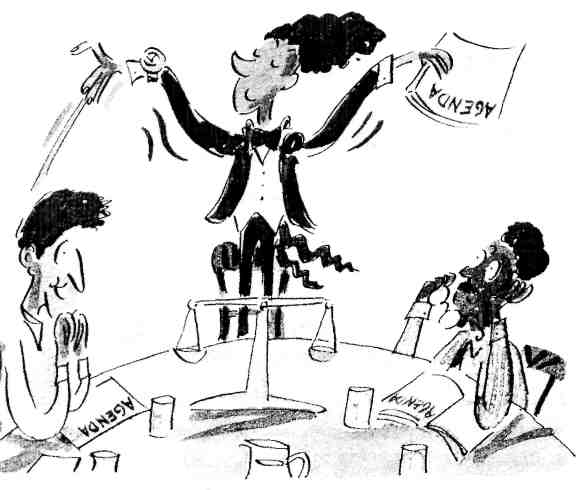
Meetings 2: the role of the chairperson
 1
Before the meeting Hilary
Rhodes is a management consultant who
specializes in meeting skills:
1
Before the meeting Hilary
Rhodes is a management consultant who
specializes in meeting skills:
‘A good chairperson has to be a good organizer. What they do before the meeting is as important as the meeting itself. They should make sure the agenda (the list of things to be discussed) is complete by asking those involved what should be on it and then circulating (distributing) it to everyone concerned. They should check the venue, making sure the room will be free, without interruptions, until the end of the meeting.’
2 During the meeting
The chairperson should be a good timekeeper. They should start the meeting on time, without waiting for latecomers.
They should appoint a minute-taker to take the minutes, making sure that opinions and action points (where participants agree to do something) are noted.
They should make sure each point on the agenda is allocated the time it deserves and should keep to the timetable. When the time allocated to one point is up, the chair should make sure that discussion moves on to the next point, even if the issue has not been completely covered or resolved (decided).
The chair should make sure that each participant has the chance to make their point, and should deal tactfully with disagreements, making sure that each side feels their point of view has been noted. They should also try to avoid digressions, where people get off the point.
Finally, they should ensure the meeting finishes on time, or early.
3 Follow-up
After some meetings, it's necessary for the minutes to be circulated, especially if there are action points that particular people are responsible for.
At the next meeting, the chair should ask for the minutes to be read out and see if all agree that it is an accurate record of what happened, and see if there are any matters arising (any points from the last meeting that need to be discussed). And they should check what progress has been made on the action points from the previous meeting.
Replace the underlined phrases in this article with the correct expressions from 1 and 2.

Look at 1, 2 and 3 above. Match the verbs (1-7) with the nouns (a-g) that they go with:
take a a minute-taker
appoint b the minutes
circulate с time
allocate d the agenda
move on e to the next point
avoid f on time
finish g digressions
The language of meetings
The following expressions are useful in meetings, but some letters are missing from the final words. When you have completed them, the letters in the box spell out a good piece of advice for the chairperson!
|
B |
_ |
_ |
_ |
N |
_ |
_ |
S |
|
|
|
|
|
|
|
|
|
M |
_ |
M |
_ |
_ |
_ |
? |
|
|
|
|
|
|
|
|
|
|
|
|
|
D |
_ |
S |
_ |
_ |
_ |
E |
E |
|
|
|
|
|
|
|
|
|
_ |
L |
_ |
_ |
R |
|
|
|
|
|
|
|
T |
H |
_ |
_ |
_ |
? |
|
|
|
|
|
|
|
|
_ |
N |
D |
_ |
_ |
S |
_ |
_ |
N |
_ |
|
|
|
|
|
|
|
|
|
|
|
P |
_ |
_ |
_ |
_ |
|
|
|
|
|
|
|
|
|
|
_ |
A |
_ |
_ |
N |
G |
|
|
|
|
|
|
|
|
|
|
|
|
_ |
N |
|
|
|
|
|
|
|
|
|
|
|
|
|
Q |
_ |
_ |
S |
_ |
_ |
O |
_ |
|
|
|
|
|
L |
_ |
_ |
E |
_ |
|
|
|
|
|
|
|
|
|
|
|
|
_ |
R |
E |
_ |
_ |
|
|
|
|
|
|
|
|
|
|
|
S |
_ |
G |
_ |
E |
_ |
_ |
I |
_ |
N |
S |
? |
|
|
|
|
|
|
H |
_ |
_ |
E |
? |
|
|
|
|
|
|
|
|
|
M |
_ |
_ |
N |
|
|
|
|
|
|
|
|
|
|
|
|
|
T |
_ |
_ |
_ |
Y |
|
|
|
|
|
|
|
|
|
|
|
|
|
_ |
F |
R |
_ |
_ |
D |
|
|
|
Which expressions are used to:
1 open a meeting □ 2 ask for information □ 3 interrupt □ □ 4 prevent interruption □ 5 get some fresh air □ |
6 speed things up □ 7 ask for clarification □ 8 disagree □ 9 half-agree □ 10 explain □ □ |
11 delay □ 12 ask for ideas □ 13 reject a proposal □ 14 close a meeting □ □ |
